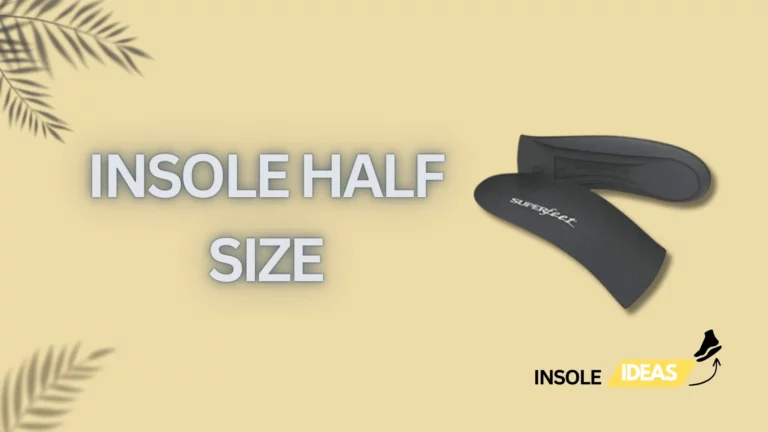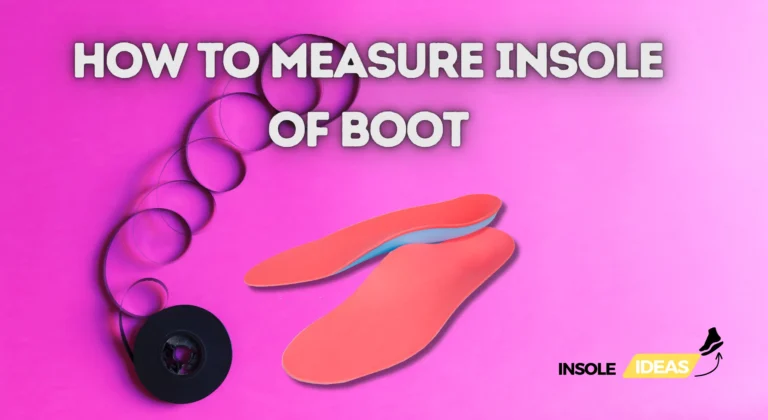Choosing the Right Insoles for Optimal Foot Health
Insoles, often referred to as shoe inserts or footbeds are placed inside shoes to provide additional support, cushioning, and foot comfort. They serve various purposes, from enhancing foot health to improving overall posture and alleviating pain. Insoles are designed to cater to different needs, whether for everyday wear, athletic performance, or specific foot conditions.
Understanding Insoles
What Are Insoles?
Insoles are inserts placed inside shoes to provide additional support, cushioning, and stability for the feet. They come in various materials such as foam, gel, or custom-made orthotics, each offering unique benefits. Whether you have high arches, flat feet or experience foot pain, insoles are designed to address specific needs and provide optimal comfort.
Benefits of Using Insoles
Using insoles offers numerous benefits for foot health and overall well-being. They provide support and stability, reducing strain on the feet and lower limbs. Insoles also help correct foot alignment and posture, preventing overpronation or supination. Additionally, they can alleviate common foot problems such as plantar fasciitis, heel pain, and metatarsalgia, enhancing comfort and mobility.
Assessing Your Needs
Identifying Foot Issues
Before selecting insoles, it’s essential to identify any underlying foot issues or conditions. Common problems include arch pain, heel spurs, bunions, and flat feet. By understanding your specific foot concerns, you can choose insoles that address these issues and provide targeted support and relief.
Understanding Foot Mechanics
Foot mechanics are crucial in determining the type of insoles that will best suit your needs. Factors such as arch type, gait pattern, and foot shape influence the choice of insoles. Understanding how your feet function and any biomechanical abnormalities will guide you in selecting the most appropriate insoles for optimal support and comfort.
Choosing the Right Insoles
When selecting the right insoles, several factors need consideration to ensure they meet your specific needs and preferences. From materials and design to compatibility with your foot type, choosing the right insoles can significantly impact your comfort and foot health.
Material and Design
The materials used in insoles play a crucial role in determining their comfort, support, and durability. Common materials include gel, memory foam, cork, and custom-made, choosing the right insoles from tics. Gel insoles provide excellent cushioning and shock for individuals with heel pain or sensitive feet. Foam insoles offer lightweight cushioning and are suitable for everyday use. Memory foam insoles conform to the shape of your foot, providing personalized support and comfort.
Consider features such as arch support, heel cupping, and metatarsal padding when evaluating insole design. Arch support helps distribute weight evenly across the foot, reducing strain on the arch and preventing overpronation or supination. A well-defined heel cup provides stability and alignment for the heel, while metatarsal padding cushions the balls of the feet, relieving pressure and discomfort.
Durability and longevity are essential factors to consider when selecting insoles. Look for insoles made from high-quality materials that withstand daily wear and tear. Reinforced stitching, anti-microbial properties, and moisture-wicking capabilities can prolong the lifespan of your insoles, keeping them fresh and odor-free for longer.
Matching Insoles to Foot Type
Choosing insoles that match your foot type is essential for maximizing comfort and support. Arch type plays a significant role in determining the insoles that provide optimal support. Individuals with high arches require insoles with ample arch support to prevent excessive pressure on the arch and heel. Medium arches benefit from moderate arch support to maintain proper alignment and stability. For individuals with low arches or flat feet, insoles with firm arch support and motion control features are recommended to reduce overpronation and provide additional support.
Customized orthotics offer personalized support tailored to your foot’s specific shape and needs. While off-the-shelf insoles are readily available and more affordable, custom-made orthotics provide superior support and comfort for individuals with unique foot characteristics or medical conditions such as plantar fasciitis or bunions.
Specialized insoles for specific conditions offer targeted support and relief for individuals experiencing foot pain or discomfort. For example, insoles with metatarsal pads or heel cushions benefit individuals with metatarsalgia or heel spurs. Selecting insoles tailored to your foot type and specific needs ensures maximum comfort and support for all-day wear.
Insoles for Different Activities
Insoles are vital in providing comfort, support, and performance enhancement for various activities, from everyday wear to athletic pursuits. Understanding the different types of insoles available for different activities can help you choose the right pair to suit your needs and lifestyle.
Everyday Use
For everyday wear, insoles should prioritize comfort and support to accommodate prolonged periods of standing or walking. Look for insoles with cushioning properties that absorb shock and reduce pressure on the feet. Addition features such as arch support and heel cupping to maintain proper alignment and reduce fatigue. Breathable materials and moisture-wicking properties help keep your feet dry and comfortable throughout the day, preventing sweat buildup and odor.
Athletic Performance
Insoles designed for athletic performance are designed to enhance comfort, support, and biomechanical efficiency during sports and exercise. These insoles often feature advanced cushioning technologies such as air or gel inserts for maximum shock absorption and impact protection. Additionally, they may include features such as arch support, metatarsal pads, and heel stabilizers to improve stability, balance, and propulsion. By providing targeted support and reducing strain on the feet and lower limbs, athletic insoles can help prevent injuries and improve overall performance. Whether running, jumping, or engaging in high-impact activities, investing in quality athletic insoles can significantly enhance your comfort and performance.
Additional Considerations
There are several additional factors to consider when considering insoles beyond just the basic features and functionalities. These considerations can significantly impact your overall satisfaction and experience with the chosen insoles.
Cost vs. Quality
One of the primary considerations when purchasing insoles is finding the right balance between cost and quality. While it’s tempting to opt for the cheapest option available, it’s essential to remember that quality often comes at a price. Investing in high-quality insoles may initially seem more expensive, but they can offer long-term benefits such as durability, better support, and improved foot health. However, you can still break the bank. There are ways to find affordable options without compromising on quality. By comparing different brands, materials, and features, you can discover insoles with a good balance of affordability and effectiveness.
Conclusion
This article has provided comprehensive guidance on selecting the right insoles to meet individual needs and preferences. We began by exploring the importance of insoles in providing support, comfort, and stability for the feet. Understanding the various insoles available and their benefits is crucial for making informed decisions.
We then delved into assessing foot issues and understanding foot mechanics to effectively match insoles to specific needs. Individuals can choose insoles that offer optimal support and alleviate discomfort by identifying common foot problems and considering factors such as arch-offering gait patterns.
Next, we discussed important considerations when choosing insoles, including the material and design features to look for and the importance of matching insoles to foot type. Selecting the right insoles for everyday use or athletic performance can significantly impact comfort and foot health.
Additionally, we explored maintenance and care tips to prolong the lifespan of insoles, emphasizing the importance of proper cleaning and recognizing signs of wear and tear. By caring for your insoles, you can ensure they continue providing the support and comfort you need.
In conclusion, we encourage readers to prioritize foot health and comfort by investing in the right insoles for their needs. Whether you’re dealing with foot pain, looking to enhance athletic performance, or simply seeking greater comfort in your everyday shoes, choosing the right insoles can make a significant difference.
Finally, we recommend seeking advice from healthcare professionals and researching user reviews to find insoles that best suit your needs and preferences. You can make confident decisions to support your foot health and well-being with the right guidance and information.






